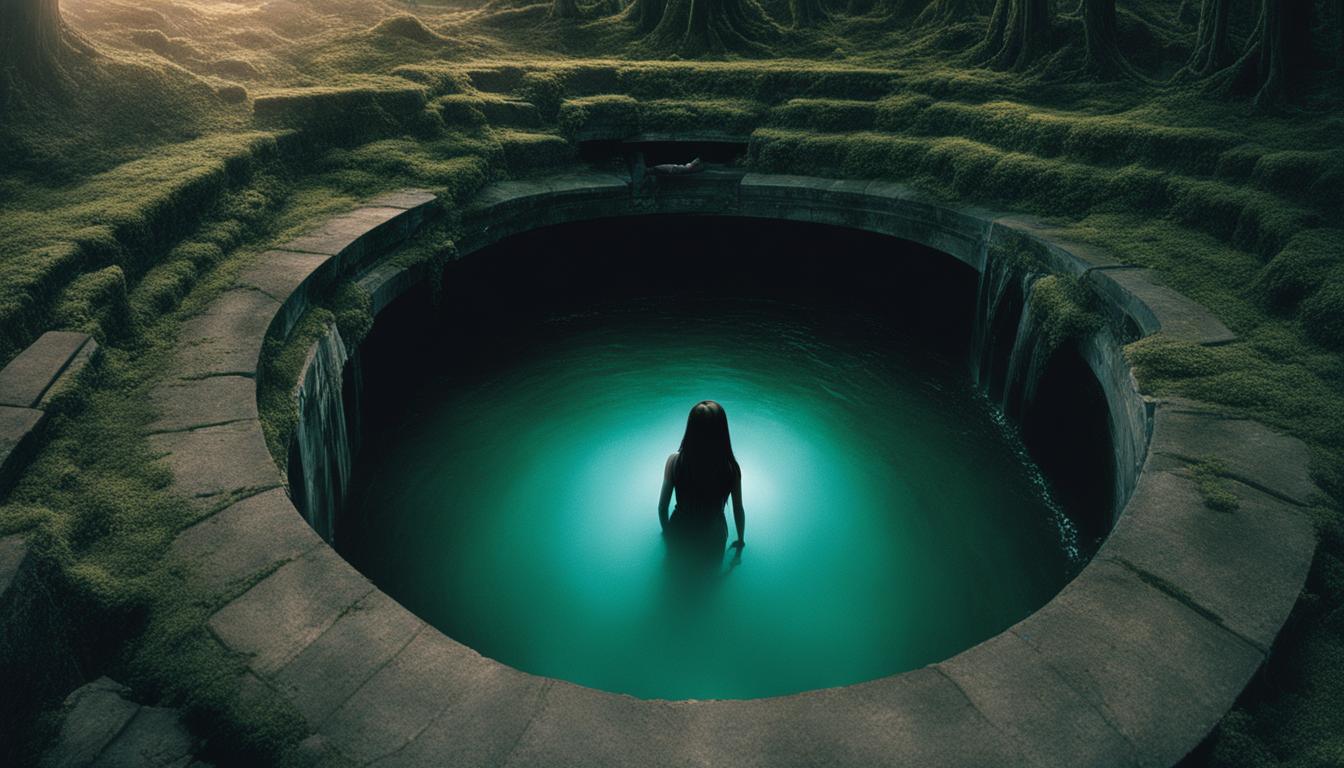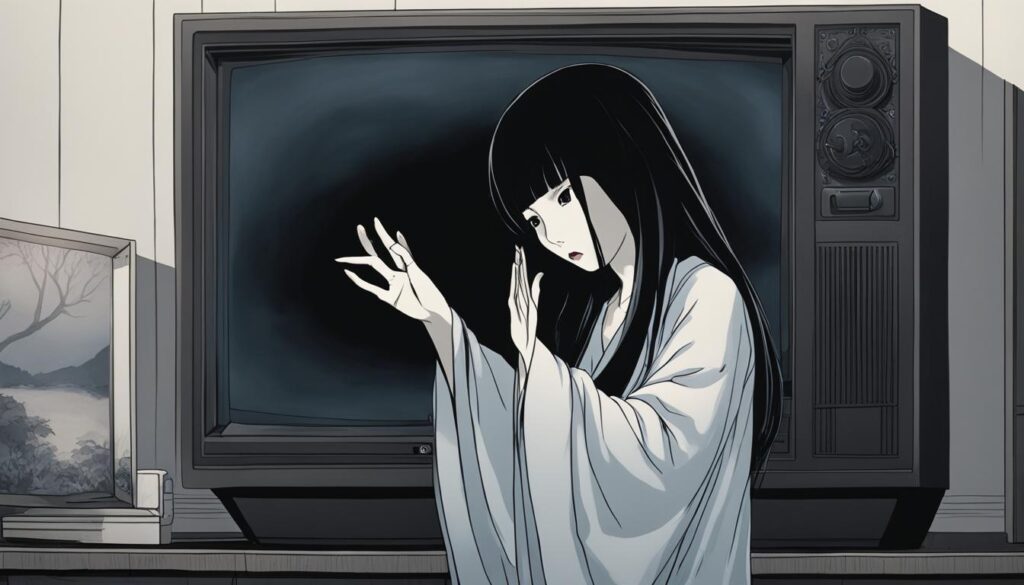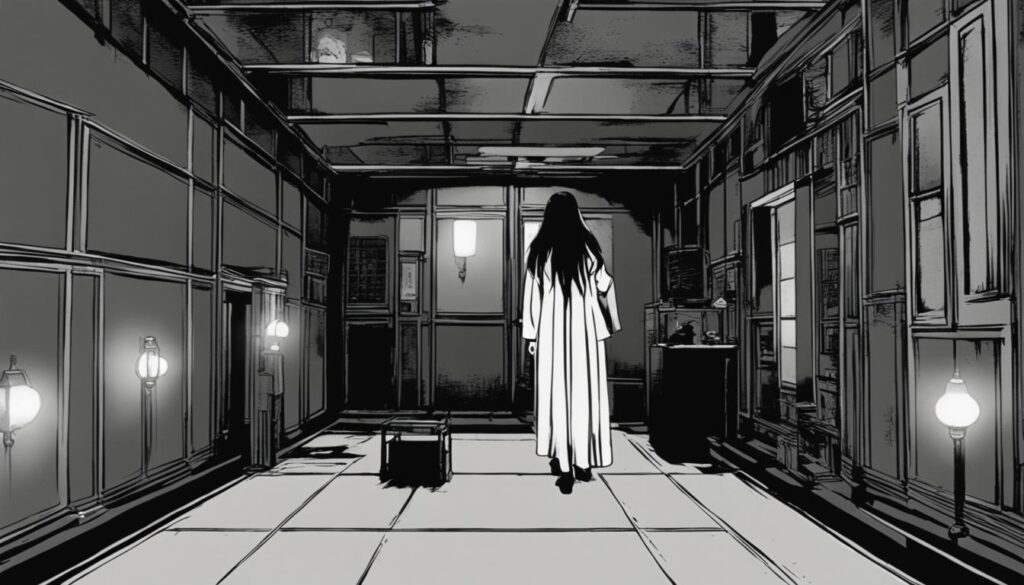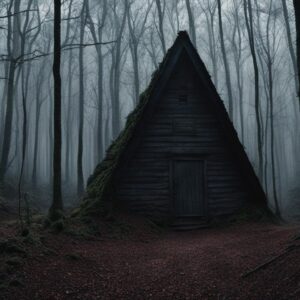When it comes to hair-raising horror movies, Ringu (1998) stands in a league of its own. This iconic Japanese horror film, directed by Hideo Nakata, takes viewers on a chilling journey into the world of supernatural terror. From the eerie urban legend of a cursed VHS tape to the iconic ghostly presence of Sadako Yamamura, Ringu captivates audiences with its blend of psychological horror and spine-tingling suspense.
At its core, Ringu explores the terrifying consequences of stumbling upon a cursed video tape, rumored to bring death upon anyone who watches it. As the mysterious and disturbing images on the tape unfold, a sense of dread and fear permeates the movie, leaving viewers on the edge of their seats. The slow-burn storytelling style allows tension to build, creating an unsettling atmosphere that keeps audiences hooked from start to finish.
One of the most captivating aspects of Ringu is the character of Sadako Yamamura, whose iconic image with long black hair and a white dress has become synonymous with Japanese horror. Based on Japanese folklore, Sadako is a vengeful spirit who instills fear through her presence alone. Her inclusion in the movie adds depth to the storytelling and contributes to the lasting impact Ringu has had on the horror genre.
What sets Ringu apart from many other horror films is its ability to deliver scares without relying on graphic violence or excessive gore. Instead, the movie embraces a more psychological approach, allowing the power of imagination to create fear and unease. This absence of gore enhances the movie’s unsettling nature, leaving a lasting impression on viewers long after the credits roll.
Ringu’s influence on the horror genre cannot be understated. Its success in Japan paved the way for international recognition and numerous Hollywood remakes, including the popular American version, The Ring. As a result, Ringu continues to captivate audiences around the world and is hailed as a cult classic.
Key Takeaways:
- Ringu (1998) is a classic Japanese horror movie that combines supernatural elements with psychological horror.
- The film revolves around a cursed video tape that brings death to anyone who watches it.
- Sadako Yamamura, the iconic ghostly antagonist, has become a symbol of Japanese horror.
- Ringu relies on psychological horror rather than gore, making it a unique and unsettling viewing experience.
- The movie’s success influenced the horror genre and led to multiple Hollywood remakes.
The Urban Legend that Terrified a Generation
Ringu (1998) revolves around the chilling urban legend of a cursed video tape that haunts its viewers. The supernatural nature of this legend sets the stage for a psychological horror experience that leaves audiences on the edge of their seats. The movie explores the terrifying consequences of encountering this cursed video and the desperate race against time to unravel its mysteries.
The cursed video tape in Ringu (1998) is the centerpiece of the urban legend that has terrified a generation. Those who watch the tape are cursed to die seven days later, adding an intense sense of urgency and dread to the story. The disturbing and mysterious images on the tape evoke a deep sense of fear and unease, making it a perfect embodiment of supernatural horror.
The psychological horror elements in Ringu (1998) add to the terrifying atmosphere. The slow-burn suspense and the gradual unraveling of the curse contribute to a feeling of profound unease. As the tension builds, the movie delves into the depths of fear and paranoia, making it a truly unsettling experience for audiences.
| Ringu (1998) | The Urban Legend that Terrified a Generation |
|---|---|
| Genre | Supernatural, Psychological Horror |
| Main Focus | Cursed video tape and its consequences |
| Key Themes | Urban legend, supernatural, psychological horror |
| Impact | Became a cult classic and influenced the horror genre |
“Ringu (1998) taps into the collective fear of cursed objects and the unknown lurking in the modern world. It takes the idea of an urban legend and transforms it into a haunting tale of supernatural horror. The combination of the cursed video tape and the psychological terror that unfolds makes Ringu an unforgettable and spine-chilling experience.” – Horror Movie Reviewer
The Terrifying Countdown Begins
After watching the cursed video tape in Ringu (1998), the protagonist, Reiko, learns that she has only seven days to live. This race against time adds a thrilling element to the supernatural and psychological horror of the movie. As the clock ticks, Reiko embarks on a desperate journey to uncover the mystery behind the curse and save herself from a horrific fate.
The countdown in Ringu intensifies the suspense, creating a sense of impending doom that keeps viewers on the edge of their seats. Each passing day brings Reiko closer to her terrifying end, and the tension mounts as she delves deeper into the dark secrets surrounding the cursed video. This race against time not only heightens the horror elements of the film but also showcases the sheer urgency and desperation of the characters.
As the days dwindle down, the audience is reminded of the inexorable passage of time and the limited window of opportunity for Reiko to break the curse. This impending deadline adds a sense of realism to the supernatural premise, grounding the horror in a tangible and relatable concept. The countdown in Ringu is a masterful storytelling technique that magnifies the terror and keeps viewers captivated until the very end.
The Psychological Toll of Time
Not only does the countdown in Ringu heighten the suspense and fear, but it also explores the psychological toll that the passage of time can take on individuals. The looming deadline forces Reiko to confront her deepest fears and grapple with her own mortality. The limited timeframe intensifies the psychological horror, pushing the characters to their limits and challenging their sanity.
In addition to the race against time, the countdown in Ringu also reflects the broader theme of time’s impermanence and the inevitability of death. It serves as a reminder that life is fleeting and that even the most terrifying situations have an expiry date. This exploration of mortality adds depth and complexity to the psychological horror elements of the film, elevating it beyond a simple tale of supernatural terror.
| Key Elements | Description |
|---|---|
| Genre | Supernatural, psychological horror |
| Plot | A cursed video tape gives viewers seven days to live |
| Effect | Intensifies suspense, creates urgency, adds psychological depth |
| Impact | Keeps viewers engaged, highlights the characters’ desperation |
The countdown in Ringu is a central element of the movie’s gripping narrative, heightening the terror and unleashing a psychological onslaught on both the characters and the audience. It serves as a powerful tool to convey the passage of time, the fragility of life, and the unrelenting horror of a supernatural curse. As the minutes tick away, the tension reaches its peak, leaving viewers breathless and immersed in the terrifying world of Ringu.
The Power of Japanese Storytelling
https://www.youtube.com/watch?v=CQ1jkNj4cZc
Japanese horror movies have a unique ability to captivate audiences with their slow-burn suspense and psychological terror. Ringu (1998), a classic of the genre, is a prime example of the power of Japanese storytelling in the world of supernatural and psychological horror.
Unlike Western horror films that often rely on jump scares and graphic violence, Ringu takes a more subdued approach, allowing the tension to build gradually. The deliberate pacing and atmospheric cinematography create an unsettling sense of unease that lingers long after the movie ends.
The slow-burn nature of Ringu enables the narrative to unfold in a methodical manner, allowing viewers to become fully immersed in the eerie world of the film. This deliberate storytelling style is a hallmark of Japanese cinema and enhances the overall impact of the movie’s supernatural elements, making it a truly unforgettable and chilling experience.
The Art of Building Suspense
In Ringu, the methodical storytelling is complemented by the skillful use of suspense-building techniques. The audience is kept on edge through the clever manipulation of visual cues, eerie sound design, and the gradual revelation of unsettling details. Every scene is meticulously crafted to heighten the sense of dread and anticipation, leading to spine-tingling moments that will leave you gripping the edge of your seat.
The combination of slow-burn suspense and supernatural elements in Ringu creates a unique and unsettling atmosphere that distinguishes it from other horror films. It proves that horror doesn’t always need to rely on excessive gore or jump scares to terrify audiences, but can instead invoke a deep psychological fear that lingers long after the credits roll.
Legacy and Influence
Ringu’s impact on the horror genre cannot be overstated. Its success not only spawned numerous sequels and spin-offs but also inspired a wave of Japanese horror films known as J-horror. These movies explored similar themes of supernatural and psychological terror while embracing the slow-burn storytelling style that Ringu popularized.
Furthermore, Ringu’s influence extended beyond Japan, becoming a global phenomenon and leading to several Hollywood remakes. Its enduring popularity and status as a cult classic solidify its place in horror cinema history, forever cementing the power and lasting impact of Japanese storytelling.
A Refreshingly Bloodless Horror Experience
Ringu (1998) offers viewers a refreshingly bloodless horror experience that relies on psychological terror rather than graphic violence. Unlike many horror movies that depend on gratuitous gore to create fear, Ringu takes a more subtle approach, leaving room for the power of imagination to instill unease and dread. This absence of explicit gore adds to the movie’s unsettling atmosphere and allows the supernatural and psychological elements to take center stage.
By eschewing graphic violence, Ringu creates a sense of terror that lingers long after the movie has ended. The absence of blood and gore forces the audience to confront their own fears and anxieties, as the horrors depicted in the film are left to the imagination. This approach taps into the primal fear of the unknown, amplifying the psychological impact of the story and leaving a lasting impression on the viewer.
“Ringu’s bloodless approach to horror allows the audience to truly engage with the story on a deeper level,” says horror film critic Mark Thompson. “By relying on suspense, atmosphere, and the power of suggestion, the movie creates a sense of dread that is impossible to shake off easily.”
The decision to forgo explicit gore in Ringu demonstrates the masterful storytelling and confidence of the filmmakers. Instead of relying on shock value, they focused on crafting a chilling narrative that explores supernatural themes and psychological horror. This choice highlights the enduring power of storytelling to evoke fear and unsettle audiences, making Ringu a standout film in the horror genre.
As viewers continue to seek out horror experiences that push boundaries and challenge conventions, Ringu remains a standout example of the genre. Its bloodless approach to horror demonstrates the impact that can be achieved through subtlety and psychological terror. Ringu’s enduring popularity and reputation as a cult classic prove that sometimes, the absence of gore can create a more lasting and haunting impact than any amount of blood and violence.
The Iconic Ghost of Japanese Horror
When it comes to Japanese horror, one name that immediately comes to mind is Sadako Yamamura, the iconic ghost from the movie Ringu (1998). Sadako’s haunting presence and eerie appearance have made her a legendary figure in the horror genre. With her long black hair and white dress, she embodies the supernatural elements that define Ringu’s psychological horror.
The character of Sadako Yamamura is based on Japanese folklore, specifically the legend of the yūrei, vengeful female spirits seeking revenge on the living. Ringu’s portrayal of Sadako as a vengeful spirit instilling fear through her mere presence taps into the long-standing tradition of Japanese ghost stories. As a result, Sadako has become an enduring figure in Japanese horror, inspiring countless imitations and parodies.
What sets Sadako apart from other horror movie ghosts is her ability to strike a chord with audiences on a deep and psychological level. The slow-burn suspense of Ringu allows the audience to become fully immersed in the terror of Sadako’s curse. The supernatural and psychological elements woven together create a truly haunting experience that lingers long after the movie ends.
| Keywords | Related Information |
|---|---|
| Ringu (1998) | The movie that introduced Sadako Yamamura and became a cult classic. |
| Supernatural | The paranormal elements that surround Sadako’s curse. |
| Psychological Horror | The slow-burn suspense and psychological terror experienced by the characters and viewers. |
| Iconic Ghost | Sadako Yamamura’s enduring image and impact on the horror genre. |
The Terrifying Power of Cursed Technology
In the world of Ringu (1998), the supernatural curse that haunts its victims is not transmitted through ancient rituals or haunted places, but through modern technology. The cursed video tape and the eerie phone calls serve as conduits for the malevolent force that terrorizes those who come into contact with them. This blending of technology and the paranormal adds a unique twist to the horror genre, as it takes something familiar and everyday and turns it into a source of fear and dread.
Through the cursed video tape, Ringu explores the idea that technology can be a vessel for evil, capable of spreading darkness and chaos. The tape itself becomes a symbol of the unknown lurking within modern society, tapping into our deepest fears of the unexplainable and the uncontrollable. The use of technology as a conduit for supernatural elements not only enhances the psychological horror of the movie but also serves as a commentary on the potential dangers of our increasing reliance on technology.
This exploration of the power of cursed technology in Ringu is a reflection of the anxieties and concerns of the time in which the movie was made. With the rise of the internet and the increasing interconnectedness of the world, there was a growing unease about the potential consequences of our technological advancements. Ringu taps into these fears and amplifies them through its chilling story, reminding us that even our most trusted devices can become instruments of terror.
In summary, Ringu (1998) demonstrates the terrifying power of cursed technology. By using modern devices as conduits for supernatural forces, the movie taps into our fears of the unknown and the potential dangers of our reliance on technology. Through its chilling story and eerie atmosphere, Ringu serves as a cautionary tale, reminding us that even the most innocent-seeming objects can hide dark secrets.
Tapping into the Rich Tradition of Japanese Ghost Stories
Japanese culture is rich with folklore and ghost stories, and Ringu (1998) skillfully draws inspiration from these traditional tales to create a truly captivating horror experience. In the film, we are introduced to the legend of the yūrei, female ghosts in white kimonos with long black hair, who seek vengeance on the living. This iconic imagery has become synonymous with Japanese horror and adds depth and cultural significance to Ringu. By incorporating these traditional elements, the movie not only showcases the unique storytelling style of Japanese cinema but also provides a chilling exploration of the supernatural.
The influence of Japanese folklore extends beyond the visual representation of the ghostly antagonist, Sadako Yamamura. It permeates the narrative, making the horror more grounded and relatable. Japanese ghost stories often focus on themes of guilt, regret, and unresolved emotions, which are beautifully woven into the plot of Ringu. The psychological impact of these supernatural elements evokes a sense of unease and keeps the audience on edge throughout the movie.
By tapping into the rich tradition of Japanese ghost stories, Ringu creates a unique horror experience that is both culturally significant and universally unsettling. It not only pays homage to the folklore that has shaped Japanese culture but also showcases the power of these stories to resonate with audiences worldwide. Ringu’s masterful blend of supernatural and psychological horror, influenced by Japanese folklore and ghost stories, cements its place as a true representation of the genre and a must-watch for horror enthusiasts.
| Japanese Ghost Stories in Ringu | Impact on the Movie |
|---|---|
| The legend of the yūrei | Iconic imagery and cultural significance |
| Themes of guilt, regret, and unresolved emotions | Deeper psychological impact and relatability |
| Influential storytelling elements | Creates a universal sense of unease |
“Ringu’s incorporation of traditional Japanese ghost stories adds depth and cultural significance to the movie, making it a true representation of the genre.” – Horror Enthusiast
A Turning Point in Japanese Horror Cinema
Ringu (1998) is widely regarded as a landmark film that revolutionized the Japanese horror genre. Its unique blend of supernatural elements and psychological horror had a profound impact on both domestic and international audiences, influencing subsequent horror movies for years to come. With its chilling atmosphere, iconic imagery, and thought-provoking storytelling, Ringu carved a path for other J-horror films to gain recognition and captivate a global audience.
One of the key factors that set Ringu apart was its departure from the traditional tropes of horror. Instead of relying on excessive gore and jump scares, the movie focused on creating a sense of unease and tension through slow-burn suspense. This shift in approach allowed for a more psychological and atmospheric horror experience that resonated with audiences on a deeper level.
“Ringu tapped into the fear of the unknown lurking within modern society, using technology as a conduit for supernatural forces. The cursed video tape and the haunting imagery it contained served as a metaphor for the unsettling presence of the supernatural in our everyday lives.”
Furthermore, Ringu introduced audiences to the iconic ghostly antagonist, Sadako Yamamura. Her striking appearance, with long black hair and a white dress, became synonymous with Japanese horror and added a cultural dimension to the film. The character drew inspiration from traditional Japanese folklore and ghost stories, bringing a rich depth to Ringu and solidifying its status as a true representation of the genre.
The Legacy of Ringu
The success of Ringu paved the way for Hollywood remakes and established a lasting legacy in the horror genre. The American adaptation, The Ring (2002), introduced Ringu to a wider global audience, further cementing its impact on international cinema. Even after more than two decades, Ringu remains a cult classic and a testament to the enduring power of Japanese horror.
| Ringu (1998) | Impact and Influence |
|---|---|
| Revolutionized Japanese horror cinema | Inspired a wave of J-horror films |
| Emphasized psychological horror over gore | Influenced global horror movies |
| Introduced iconic ghostly antagonist, Sadako Yamamura | Inspired parodies and imitations |
| Blended supernatural and psychological elements | Created a new wave of atmospheric horror |
From its impact on the genre to its enduring popularity, Ringu will always be remembered as a turning point in Japanese horror cinema. Its ability to evoke fear and leave a lasting impression on audiences showcases the timeless nature of its storytelling and confirms its place among the greatest horror films of all time.
A Cult Classic That Continues to Send Chills Down the Spine
When it comes to Japanese horror movies, few can compare to the chilling and unforgettable experience of Ringu (1998). This supernatural psychological horror film has gained a cult following over the years and continues to captivate audiences with its eerie atmosphere and thought-provoking storytelling. Ringu is a true masterpiece of the genre and remains a must-watch for fans of Japanese horror and cinema in general.
Ringu’s enduring popularity can be attributed to its unique blend of supernatural elements and psychological horror. The movie revolves around a cursed video tape that brings about a terrifying curse, where viewers are doomed to die in seven days. This premise sets the stage for a race against time as the protagonist, Reiko, delves into the mystery behind the curse to save her own life. The suspenseful countdown and the unknown lurking within modern technology create an unsettling atmosphere that keeps viewers on the edge of their seats.
What sets Ringu apart from other horror movies is its ability to instill fear without relying on graphic violence and gore. Instead, it taps into the power of imagination, leaving viewers to fill in the gaps with their own worst fears. The absence of explicit gore allows for a more subtle and psychological approach to horror, making it all the more unsettling. Ringu proves that true horror lies not in what is shown, but in what is left to the imagination.
With its iconic ghostly antagonist, Sadako Yamamura, and its masterful storytelling, Ringu continues to be a timeless classic that sends chills down the spine. Its impact on the horror genre cannot be overstated, inspiring numerous Hollywood remakes and influencing filmmakers around the world. Ringu remains a true cult classic that will continue to haunt audiences for years to come.
Spreading the Curse to a Global Audience
Ringu (1998) not only captivated audiences in Japan but also spread its supernatural and psychological horror to a global audience through Hollywood remakes. The success of Ringu paved the way for the creation of several American versions, including the popular film, The Ring. These remakes introduced Ringu’s unique brand of terror to a wider audience, solidifying its status as a seminal horror film.
The legacy of Ringu extends beyond its original release, with its influence leaving a lasting impact on the horror genre. By blending traditional Japanese folklore and ghost stories with modern technology as a conduit for evil, Ringu offered a fresh take on horror that resonated with audiences worldwide. The eerie atmosphere, creepy imagery, and thought-provoking storytelling of Ringu set a new standard for what horror films could achieve.
The success of Ringu paved the way for the creation of several American versions, including the popular film, The Ring.
Ringu’s impact on the genre can still be felt today, as its innovative approach continues to inspire filmmakers. The movie’s influence can be seen in the way subsequent horror movies incorporate elements of supernatural and psychological horror, creating a lasting legacy for Ringu in the annals of horror cinema.
| Hollywood Remakes of Ringu | Release Year |
|---|---|
| The Ring | 2002 |
| The Grudge | 2004 |
| Dark Water | 2005 |
Table: Hollywood remakes of Ringu and their release years.
Ringu’s enduring popularity and continuing influence in the horror genre solidify its status as a classic that will continue to terrify audiences for years to come. Whether it’s the iconic ghostly presence of Sadako Yamamura or the chilling blend of supernatural and psychological horror, Ringu remains a must-watch for fans of Japanese horror and cinema in general.
A Horror Classic that Stands the Test of Time
When it comes to Japanese horror movies, few can compare to the timeless terror of Ringu (1998). This supernatural and psychological horror film has captivated audiences for over two decades with its chilling atmosphere and iconic imagery. Ringu has carved its place in the annals of horror cinema as a true cult classic.
What sets Ringu apart from other horror movies is its ability to evoke fear and unease using subtle and imaginative techniques. Instead of relying on graphic violence and gore, Ringu takes a more psychological approach, tapping into the power of suggestion and the unknown. The slow-burn suspense and deliberate storytelling style create a sense of dread that lingers long after the credits roll.
At the heart of Ringu is the unforgettable character of Sadako Yamamura, the vengeful ghost who has become an iconic figure in Japanese horror. With her long black hair and white dress, Sadako’s presence instills fear and dread in viewers. Her image has become synonymous with the horror genre and continues to haunt audiences to this day.
| Key Features of Ringu (1998) | Keywords |
|---|---|
| Supernatural and psychological horror | Japanese horror movie, supernatural, psychological horror |
| Slow-burn suspense and deliberate storytelling | Japanese horror movie, supernatural, psychological horror, timelessness |
| Iconic ghostly antagonist | Ringu (1998), Sadako Yamamura, supernatural, psychological horror, iconic ghost |
| Refreshing absence of gore | Ringu (1998), Japanese horror movie, supernatural, psychological horror, absence of gore |
| Inspired by Japanese folklore and ghost stories | Ringu (1998), Japanese horror movie, supernatural, Japanese folklore, ghost stories |
| Impact and influence on Japanese horror cinema | Ringu (1998), Japanese horror movie, supernatural, psychological horror, impact, influence |
| Cult classic status | Ringu (1998), Japanese horror movie, supernatural, psychological horror, cult classic |
| Global reach and Hollywood remakes | Ringu (1998), Japanese horror movie, supernatural, psychological horror, Hollywood remakes, legacy |
With its timeless themes of supernatural terror and psychological horror, Ringu continues to be a must-watch for fans of the genre. Its impact on Japanese horror cinema and its enduring popularity make it a true classic that will continue to terrify audiences for years to come.
Experience the Chilling Horror of Ringu (1998)
Ringu (1998) is a pinnacle of Japanese horror that continues to send chills down the spine years after its release. As a fan of the genre, I can confidently say that this cult classic is a must-watch for any horror enthusiast.
The movie’s supernatural and psychological elements blend seamlessly to create a truly terrifying experience. From the iconic ghostly antagonist, Sadako Yamamura, to the eerie and unsettling atmosphere, Ringu keeps you on the edge of your seat from start to finish.
What sets Ringu apart from other horror movies is its ability to evoke fear through subtlety rather than relying on explicit gore. It’s a refreshing approach that allows your imagination to run wild, making the horror even more intense and unnerving.
If you’re looking for a Japanese horror movie that will stay with you long after the credits roll, Ringu (1998) is the film for you. Prepare to be immersed in a world of supernatural terror and experience firsthand why this movie is considered a true cult classic.
FAQ
What is Ringu (1998) about?
Ringu revolves around the urban legend of a cursed video tape that kills its viewers after seven days.
Is Ringu considered a cult classic?
Yes, Ringu is considered a cult classic and has been copied numerous times.
Does Ringu have a slow pace?
Yes, Ringu is known for its slow pacing, which can be off-putting to some viewers.
What makes Ringu a unique horror movie?
Ringu incorporates supernatural and psychological horror elements, creating a truly unsettling atmosphere.
Is Ringu a graphic and gory movie?
No, Ringu is refreshingly bloodless and relies on psychological horror rather than explicit gore.
Who is Sadako Yamamura?
Sadako Yamamura is the ghostly antagonist of Ringu, an iconic figure in Japanese horror.
How does technology play a role in Ringu?
In Ringu, technology becomes a conduit for evil, with the cursed video tape and eerie phone calls serving as mediums for the supernatural curse.
Does Ringu draw inspiration from Japanese folklore?
Yes, Ringu incorporates elements from Japanese folklore and ghost stories, specifically the legend of the yūrei.
Has Ringu influenced the horror genre?
Yes, Ringu is widely regarded as a turning point in Japanese horror cinema and has influenced subsequent horror movies around the world.
Is Ringu still popular today?
Yes, Ringu continues to be revered as a cult classic and remains a staple of Japanese horror.
Were there any Hollywood remakes of Ringu?
Yes, Ringu’s success led to the creation of several Hollywood remakes, including the popular American version, The Ring.
Is Ringu a timeless horror movie?
Yes, Ringu has retained its popularity and continues to terrify audiences, showcasing its timelessness.
Should I watch Ringu?
Yes, Ringu is a must-watch for fans of Japanese horror and cinema in general, offering a chilling and thought-provoking experience.







